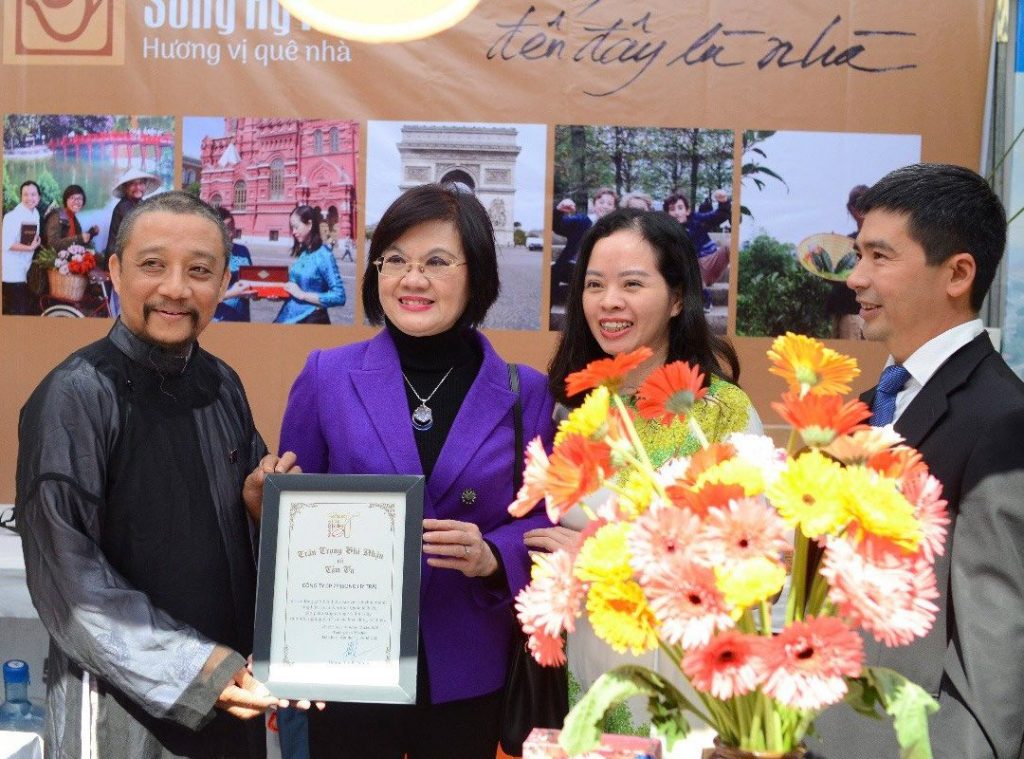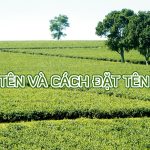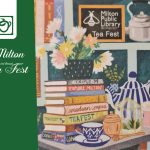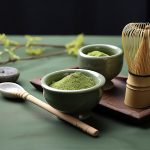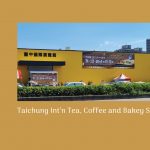Madame – Ambassador Nguyen Nguyet Nga and Mr. Nguyen Ngoc Tuan – Traditional Tea Artisan (standing on the far left) at the Food Festival organized by the Department of Foreign Affairs – Ministry of Foreign Affairs of Vietnam.
Tea culture has become a remarkable symbol in Vietnamese traditional culture.
The quintessence of Vietnamese Tea is created along with the history of customs and habits as well as the very typical religious interference between Heaven and Earth of Vietnamese people. As a traditional ritual, Vietnameses usually start the conversation by offering guests tea. There are countless flavors of tea across the length of the S-shaped country, but “Che” is the one that has become a legend.
On the occasion of International Tea Day (May 21), The World & Vietnam Report has an interview with Mr. Nguyen Ngoc Tuan – a traditional tea artisan on “the quintessence of Vietnamese Tea”.
Reporter: Dear Mr. Nguyen Ngoc Tuan The Vietnamese Tea Culture has existed for a long time and been recorded in many documents. From your point of view, does this culture at present change much compared to that of the past?
Artisan Nguyen Ngoc Tuan: Culture is the harmonization between the human being with nature and society. Therefore, the Vietnamese Tea Culture is not an exception. People have witnessed many time changes. Nowadays, young generations are keen on learning about tea and drink more tea. Tea is for everyone unlike before was for the older. At the moment, many new kinds of tea are introduced into the market, such as milk tea, but the core culture of enjoying tea of Vietnamese people is still preserved through generations. Tea has been a part of Vietnamese people’s life. The unique way of drinking fresh tea has existed for thousands of years. Teapots and tea tools are still neat and simple. The first thing when guests come over is to offer them tea. Parents often rub tea leaves on the feet of newborn children so that they have strong legs to go to the forest. Many people still worship the forest God or Co Tam Che in the Mother Religion to pray for an abundant crop.
What is the most important factor in the Vietnamese Tea Culture?
The 6 main factors of the drinking tea process which is also made the art of drinking tea culture in Vietnam consist: water, tea, way of making tea, teapot, space, and sound. To be specific, space here can be a tea table in the living room, on the porch, or a space in the middle of a deserted forest or in a meditation space at a peaceful temple. The sound means the sound of boiling water, the wind blowing through the bamboo bushes, the singing birds or the sound of a flute. These are the six necessary and sufficient factors in enjoying tea to have the desired cup of tea. Without any one of them, it is difficult to achieve the perfect art of drinking tea. In addition, the person who makes tea plays an equally important role. They must be thoroughly knowledgeable in choosing tea, water, teapot; master how to make each type of tea while choosing the perfect space and time for tea enjoyment. They will bring the “Love” in the Vietnamese Tea Culture to those who drink tea.
How many ways to make Vietnamese tea?
To put it simply, making tea is pouring boiling water into the tea. All teas are made in the same way. However, tea plants in different soils and climates will give their unique flavor. People in each region also have different ways of making tea and enjoying tea. For example, when making tea, Northern Vietnam uses stems and leaves while Central Vietnam uses the whole branch of tea trees. Or, the mountainous area is the home of Shan Tuyet tea, which is different from the specialization in producing green tea of midland plains.
The water to make tea is very important. When enjoying Vietnamese tea, how is water selected?
There is a well-known quote: “Water is the mother of Tea”. Therefore, the role of water is crucial and affects the quality of the teacup. Therefore, Tea Sommeliers must pay attention to the choice of water. Good water must meet the following standards: soft water, transparent color, no turbidity, fresh and sweet taste, cool temperature, clean source of water, full of vitality (rich in oxygen). There is a Vietnamese proverb that says: “Water in the creek, tea in the mountain”. That is to say, decent water is obtained from spring water flowing through gravel, rocks; river water midstream or upstream; rainwater after the first rain; rainwater stored in clean jars; dew drops on early autumn and winter leaves; water on lotus leaves in summer. The good choice of water will bring out the hidden value in the dried tea leaves, causing the characteristic properties of the tea to be “awakened”.
When making tea, it is necessary to choose boiling water with a certain temperature suitable for each type of tea. Vietnam classifies Tea into 4 types: White Tea, Green Tea, Semi-fermented Tea and 100% Fermented Tea. In my experience, with white tea, the temperature should be about 80 – 85 degrees Celsius and the brewing time is about 45 seconds. Green tea in the midland plains (like Thai Nguyen’s green tea) should be kept at about 60 – 65 degrees Celsius and not steeped for more than 5 seconds; Green tea from Shan Tuyet tea tree in the mountains should fluctuate between 70 – 75 degrees Celsius, the brewing time is about 30 seconds. Semi-fermented tea has two levels: for fermented tea from 40% to 60%, brewing temperature ranges between 70-75 degrees Celsius with 30 seconds of brewing. The tea fermented from 60% to 80% should be kept at 80 to 85 degrees Celsius, the brewing time is 30 seconds. 100% fermented tea such as black tea, herbal tea requires a temperature of 99 degrees Celsius and a brewing time from 45 seconds to 60 seconds. The tea brewing time I mentioned here is the only suggestion, drinkers can adjust according to their taste. Each time you brew tea, you should pour all the water into the kettle so that you don’t soak the tea. When brewing tea, pour all the water in the teapot, do not steep the tea. Each time the breaking continues like that, we will have teacups with different flavors after each brewing, which will increase the feeling of excitement when enjoying tea.
Vietnamese people know how to make ceramics for a long time and there are many famous production areas around the country such as Phu Lang, Bat Trang, Lai Thieu, Bien Hoa. To boil water, people used clay pots in the old days. At present, this old-fashion pot is replaced by convenient electric kettles. In the Vietnamese tea ceremony, however, “Tich pot” is a distinct highlight, which is widely used in both rural and urban areas. The special pot has many different sizes, available for both family use and professional use. Depend on the use, the volume of “tich pot” ranges from 250ml to 1 liter. Many other 6-cup porcelain teapots have also become popular with the feature that the pot has a small capacity of less than 200ml. In addition to teapots produced domestically, Vietnam also imported teapots from China. There is a special line of teapot called “Ky Kieu” kettles, which refer to custom-made pots from China but the verses engraved on it bring the soul of Vietnam. During the Nguyen Dynasty, the style kettle was used a lot in royal palaces. In 2005, we saw the appearance of a new line of teapots of the Song Hy Tra brand.
Is there any principle in tea selection, sir?
There are four seasons in a year: Spring – Summer – Autumn – Winter. There are 4 periods of time in a day: Morning – Noon – Afternoon – Evening. Because it is associated with the weather, the selection of tea must be appropriate according to the season to get the most delicious cup of tea, according to the criteria of the Tran Dynasty. Starting with the first tea crop of the year, everyone is waiting for Thanh Minh tea buds. This green tea crop in the midlands is considered the most delicious tea buds and the most important crop of the year. As for the autumn tea crop in the mountainous area, the ancient Shan Tuyet tea trees give the best flavor when absorbing the quintessence of the intermingling heaven and earth. The hot atmosphere after the Lunar New Year brings the best quality for oolong tea.
As mentioned above, the art of the Drinking Tea Culture of Vietnam consists of Water, Tea, a way of making tea, Teapot, Space, and Sound. Comparing the tea culture of Vietnam and China, we see the similarity that it has a long history of development from 3,000 to 4,000 years, the same view that emphasizes the choice of… However, the Vietnamese tea culture has the following differences:
Firstly, Chinese tea prefers rustic tea while Vietnamese people love both rustic tea and flower-flavored teas, especially lotus-scented tea. Besides, Vietnamese people also drink “fresh tea”. Vietnamese like to drink tea with a bitter, acrid taste and often very strong taste. However, the Chinese don’t drink tea that way, they pay attention to the flavor of tea and take it lighter. To be noted, Vietnamese people barely put milk in tea.
Secondly, the tools in making tea also show many differences. Chinese tea tools are diversified with gorgeous decorated tea tables. Meanwhile, Vietnamese people like neatness and simplicity. The most common Vietnamese tea set is just one pot and six cups. Vietnamese tend to simplify tea tools and preparation.
Thirdly, the space for tea enjoyment is a big dissimilarity. The Chinese prefer a private space for enjoying tea with space decoration that promotes traditional Chinese culture. Vietnamese people just need a clean and peaceful space to enjoy a happy atmosphere. They are not too attached to space but the “Love” for the tea and for those who drink with them.
Finally, the Sound while enjoying tea has its characteristics of each country, this is the easiest distinctive feature to recognize. In general, despite absorbing the influence of Chinese or Western culture, but Vietnamese Tea Culture still retains its features and does not follow rigid principles. The factor that makes up the tea culture of Vietnamese people is the love of simplicity, harmony and equality. Our people value tea friends more than any other factor.
Thai Nguyen is known as a typical “capital” of Vietnamese Tea. In your opinion, what are the unique cultural features of Thai Nguyen Tea Culture?
The Kinh ethnic group explored Thai Nguyen in the early years of the 20th century, brought tea plants here so that today this midland land becomes a typical “capital” producing mainly green tea, which is famous throughout the country and even abroad. The characteristic of tea culture here is the mesmerizing image of the “Tea Lady” in traditional costumes on the tea hills. In addition, the lively “five days, two sessions” market is another beauty in Thai Nguyen’s tea culture.
In conclusion, what is special about Vietnamese Tea Culture and the Vietnamese way of drinking Tea?
The special thing in tea culture and the way Vietnamese people drink tea is the value of “Love” always attached to the tea table. The “love” here is expressed in respect when offering tea. The host will personally make tea to entertain guests and to start the conversation. At the tea-table, all distances are removed, regardless of rich or poor, only precious feelings toward each other remain. The sincerity in the way of tea enjoyment time has created a special feature in Vietnamese tea culture.
Thanks for your meaningful sharing!

